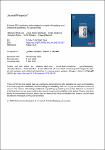At home EEG monitoring technologies for people with epilepsy and intellectual disabilities: A scoping review
| dc.contributor.author | Milne-Ives, M | |
| dc.contributor.author | Dunn-Henriksen, J | |
| dc.contributor.author | Blaabjerg, L | |
| dc.contributor.author | Mclean, B | |
| dc.contributor.author | Shankar, R | |
| dc.contributor.author | Meinert, E | |
| dc.date.accessioned | 2023-05-19T10:22:02Z | |
| dc.date.available | 2023-05-19T10:22:02Z | |
| dc.date.issued | 2023-05-18 | |
| dc.identifier.issn | 1059-1311 | |
| dc.identifier.issn | 1532-2688 | |
| dc.identifier.uri | https://pearl.plymouth.ac.uk/handle/10026.1/20901 | |
| dc.description.abstract |
BACKGROUND: Conducting electroencephalography in people with intellectual disabilities (PwID) can be challenging, but the high proportion of PwID who experience seizures make it an essential part of their care. To reduce hospital-based monitoring, interventions are being developed to enable high-quality EEG data to be collected at home. This scoping review aims to summarise the current state of remote EEG monitoring research, potential benefits and limitations of the interventions, and inclusion of PwID in this research. METHODS: The review was structured using the PRISMA extension for Scoping Reviews and the PICOS framework. Studies that evaluated a remote EEG monitoring intervention in adults with epilepsy were retrieved from the PubMed, MEDLINE, Embase, CINAHL, Web of Science, and ClinicalTrials.gov databases. A descriptive analysis provided an overview of the study and intervention characteristics, key results, strengths, and limitations. RESULTS: 34,127 studies were retrieved and 23 were included. Five types of remote EEG monitoring were identified. Common benefits included producing useful results of comparable quality to inpatient monitoring and patient experience. A common limitation was the challenge of capturing all seizures with a small number of localised electrodes. No randomised controlled trials were included, few studies reported sensitivity and specificity, and only three considered PwID. CONCLUSIONS: Overall, the studies demonstrated the feasibility of remote EEG interventions for out-of-hospital monitoring and their potential to improve data collection and quality of care for patients. Further research is needed on the effectiveness, benefits, and limitations of remote EEG monitoring compared to in-patient monitoring, especially for PwID. | |
| dc.format.extent | 11-20 | |
| dc.format.medium | Print-Electronic | |
| dc.language | en | |
| dc.publisher | Elsevier BV | |
| dc.subject | Epilepsy | |
| dc.subject | Remote monitoring | |
| dc.subject | Electroencephalography | |
| dc.subject | EEG | |
| dc.subject | Seizures Home care services | |
| dc.title | At home EEG monitoring technologies for people with epilepsy and intellectual disabilities: A scoping review | |
| dc.type | journal-article | |
| dc.type | Review | |
| plymouth.author-url | https://www.ncbi.nlm.nih.gov/pubmed/37295277 | |
| plymouth.volume | 110 | |
| plymouth.publisher-url | http://dx.doi.org/10.1016/j.seizure.2023.05.007 | |
| plymouth.publication-status | Published | |
| plymouth.journal | Seizure | |
| dc.identifier.doi | 10.1016/j.seizure.2023.05.007 | |
| plymouth.organisational-group | |Plymouth | |
| plymouth.organisational-group | |Plymouth|Research Groups | |
| plymouth.organisational-group | |Plymouth|Faculty of Health | |
| plymouth.organisational-group | |Plymouth|Faculty of Health|School of Nursing and Midwifery | |
| plymouth.organisational-group | |Plymouth|Users by role | |
| plymouth.organisational-group | |Plymouth|Users by role|Academics | |
| plymouth.organisational-group | |Plymouth|Users by role|Post-Graduate Research Students | |
| plymouth.organisational-group | |Plymouth|Research Groups|FoH - Applied Parkinson's Research | |
| dc.publisher.place | England | |
| dcterms.dateAccepted | 2023-05-07 | |
| dc.date.updated | 2023-05-19T10:21:56Z | |
| dc.rights.embargodate | 2023-5-23 | |
| dc.identifier.eissn | 1532-2688 | |
| dc.rights.embargoperiod | forever | |
| rioxxterms.versionofrecord | 10.1016/j.seizure.2023.05.007 |


